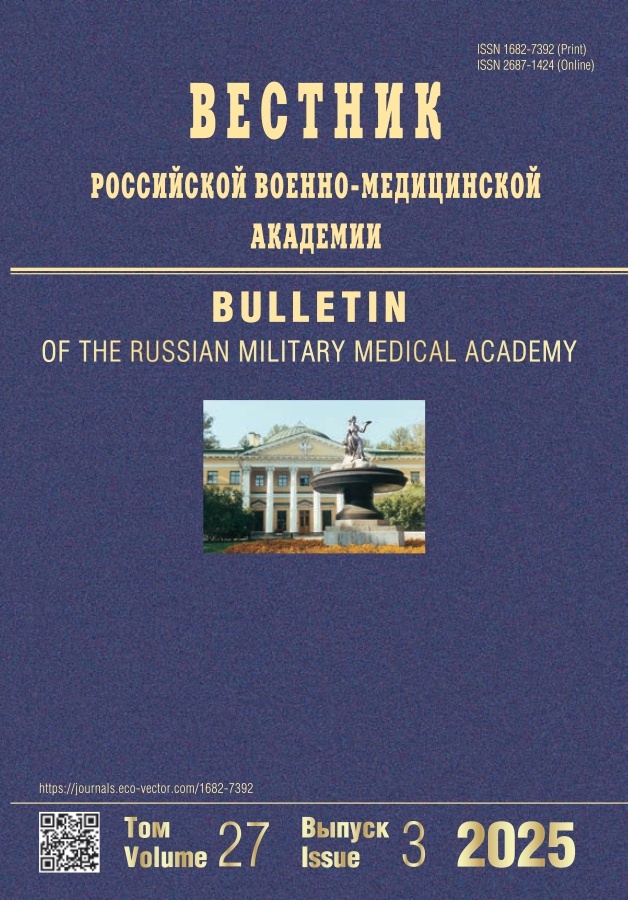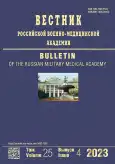Relationship of the myostatin level and secondary sarcopenia in patients undergoing programmed hemodialysis
- Authors: Tsygan V.N.1, Boriskina O.L.1, Yakovenko A.A.2, Tutin A.P.3
-
Affiliations:
- Kirov Military Medical Academy
- First Pavlov Petersburg State Medical University
- Saint Petersburg Dialysis Centre (Kupchino)
- Issue: Vol 25, No 4 (2023)
- Pages: 619-627
- Section: Original Study Article
- URL: https://journals.rcsi.science/1682-7392/article/view/253754
- DOI: https://doi.org/10.17816/brmma601821
- ID: 253754
Cite item
Abstract
The role of myostatin in the development of sarcopenia in patients receiving programed hemodialysis and the severity of the relationship with other risk factors, particularly between the myostatin level in the blood and skeletal muscle indicators, were analyzed. A single-stage prospective non-interventional study was conducted among 196 patients (97 women and 99 men, aged 54–66 years) receiving programed hemodialysis. After signing the informed consent form, all patients underwent a series of examinations consisting of the assessment of anthropometric data, measurement of vital signs, determination of the state of the muscular system for the diagnosis of sarcopenia, including bioimpedance, and laboratory tests (clinical and biochemical blood tests). The level of myostatin in the blood serum of patients was determined once 10 min before the next hemodialysis session. A statistically significant negative correlation of myostatin level with age (ρ = –0. 361; p < 0. 001), skeletal muscle strength (ρ = –0. 140; p = 0. 05), and walking speed (ρ = –0. 245; p < 0. 001) was observed. High myostatin levels were more often detected in men (U = 2633, z = –5. 462; p < 0. 001). A positive correlation between the levels of myostatin and interleukin-6 was found (ρ = 0. 410; p < 0. 001). The use of myostatin for the diagnosis of sarcopenia had a sensitivity of 71. 4%, specificity of 71. 4%, cut-off point of 5. 01 ng/mL, and area under the curve of 0. 714 (95% confidence interval: 0. 632–0. 795; p < 0. 001). An increase in myostatin levels above 5. 01 ng/mL increases the likelihood of sarcopenia by 6. 25 times (95% confidence interval: 3. 314–11. 788; χ2 = 34. 639; p < 0. 001). The chances of an increase in myostatin above the threshold value by 2,196 times according to the results of a short international questionnaire for determining physical activity (95% confidence interval: 1. 209–3. 988; χ2 = 6. 78; p = 0. 009) were higher in patients with reduced physical activity than in patients with normal physical activity. In general, in patients with chronic kidney disease receiving programed hemodialysis, along with the determination of myostatin level, a positive statistically significant association of myostatin level with interleukin-6, male sex, age, and decreased physical activity was noted, and myostatin could be used as a predictor of sarcopenia.
Full Text
##article.viewOnOriginalSite##About the authors
Vasily N. Tsygan
Kirov Military Medical Academy
Email: vn-t@mail.ru
ORCID iD: 0000-0003-1199-0911
SPIN-code: 7215-6206
Scopus Author ID: 6603136317
MD, Dr. Sci. (Med.), Professor
Russian Federation, Saint PetersburgOlga L. Boriskina
Kirov Military Medical Academy
Author for correspondence.
Email: okhrushcheva@ya.ru
ORCID iD: 0000-0001-9895-7836
SPIN-code: 4106-3705
senior clinical research associate
Russian Federation, Saint PetersburgAleksandr A. Yakovenko
First Pavlov Petersburg State Medical University
Email: leptin-rulit@mail.ru
ORCID iD: 0000-0003-1045-9336
SPIN-code: 7238-0048
MD, Cand. Sci. (Med.)
Russian Federation, Saint PetersburgAlexey P. Tutin
Saint Petersburg Dialysis Centre (Kupchino)
Email: kupchino.dialysis@gmail.com
ORCID iD: 0000-0001-8648-9086
SPIN-code: 4430-2767
Head of the Department
Russian Federation, Saint PetersburgReferences
- Carrero JJ, Johansen KL, Lindholm B, et al. Screening for muscle wasting and dysfunction in patients with chronic kidney disease. Kidney Int. 2016;90(1):53–66. doi: 10.1016/j.kint.2016.02.025
- Cruz-Jentoft AJ, Baeyens JP, Bauer JM, et al. Sarcopenia: European consensus on definition and diagnosis: Report of the European Working Group on Sarcopenia in Older People. Age Ageing. 2010;39(4):412–423. doi: 10.1093/ageing/afq034
- Souza VA, Oliveira D, Barbosa SR, et al. Sarcopenia in patients with chronic kidney disease not yet on dialysis: Analysis of the prevalence and associated factors. PLoS One. 2017;12(4):e0176230. doi: 10.1371/journal.pone.0176230
- Bataille S, Serveaux M, Carreno E, et al. The diagnosis of sarcopenia is mainly driven by muscle mass in hemodialysis patients. Clin Nutr. 2017;36(6):1654–1660. doi: 10.1016/j.clnu.2016.10.016
- Ohsawa Y, Hagiwara H, Nakatani M, et al. Muscular atrophy of caveolin-3-deficient mice is rescued by myostatin inhibition. J Clin Invest. 2006;116(11):2924–2934. doi: 10.1172/JCI28520
- Workeneh BT, Rondon-Berrios H, Zhang L, et al. Development of a diagnostic method for detecting increased muscle protein degradation in patients with catabolic conditions. J Am Soc Nephrol. 2006;17(11):3233–3239. doi: 10.1681/ASN.2006020131
- Wang XH, Mitch WE. Mechanisms of muscle wasting in chronic kidney disease. Nat Rev Nephrol. 2014;10(9):504–516. doi: 10.1038/nrneph.2014.112
- Bataille S, Chauveau P, Fouque D, et al. Myostatin and muscle atrophy during chronic kidney disease. Nephrol Dial Transplant. 2021;36(11):1986–1993. doi: 10.1093/ndt/gfaa129
- Pirruccello-Straub M, Jackson J, Wawersik S, et al. Blocking extracellular activation of myostatin as a strategy for treating muscle wasting. Sci Rep. 2018;8(1):2292. doi: 10.1038/s41598-018-20524-9
- Verzola D, Barisione C, Picciotto D, et al. Emerging role of myostatin and its inhibition in the setting of chronic kidney disease. Kidney Int. 2019;95(3):506–517. doi: 10.1016/j.kint.2018.10.010
- Mitch WE, Medina R, Grieber S, et al. Metabolic acidosis stimulates muscle protein degradation by activating the adenosine triphosphate-dependent pathway involving ubiquitin and proteasomes. J Clin Invest. 1994;93(5):2127–2133. doi: 10.1172/JCI117208
- Hu Z, Wang H, Lee IH, et al. Endogenous glucocorticoids and impaired insulin signaling are both required to stimulate muscle wasting under pathophysiological conditions in mice. J Clin Invest. 2009;119(10):3059–3069. doi: 10.1172/JCI38770
- Zhang L, Pan J, Dong Y, et al. Stat3 activation links a C/EBPδ to myostatin pathway to stimulate loss of muscle mass. Cell Metab. 2013;18(3):368–379. doi: 10.1016/j.cmet.2013.07.012
- Zhang L, Rajan V, Lin E, et al. Pharmacological inhibition of myostatin suppresses systemic inflammation and muscle atrophy in mice with chronic kidney disease. FASEB J. 2011;25(5):1653–1663. doi: 10.1096/fj.10-176917
- Zhang L, Wang XH, Wang H, et al. Satellite cell dysfunction and impaired IGF-1 signaling cause CKD-induced muscle atrophy. J Am Soc Nephrol. 2010;21(3):419–427. doi: 10.1681/ASN.2009060571
- Mitra A, Qaisar R, Bose B, et al. The elusive role of myostatin signaling for muscle regeneration and maintenance of muscle and bone homeostasis. Osteoporos Sarcopenia. 2023;9(1):1–7. doi: 10.1016/j.afos.2023.03.008
- Schellino R, Boido M, Vrijbloed JW, et al. Synergistically acting on myostatin and agrin pathways increases neuromuscular junction stability and endurance in old mice. Aging Dis. 2023. doi: 10.14336/AD.2023.0713-1
- Jang JY, Kim D, Kim ND. Pathogenesis, intervention, and current status of drug development for sarcopenia: A review. Biomedicines. 2023;11(6):1635. doi: 10.3390/biomedicines11061635
- Lee SJ, Bhasin S, Klickstein L et al. Challenges and future prospects of targeting myostatin/activin a signaling to treat diseases of muscle loss and metabolic dysfunction. J Gerontol A Biol Sci Med Sci. 2023;78(1):32–37. doi: 10.1093/gerona/glad033
Supplementary files










